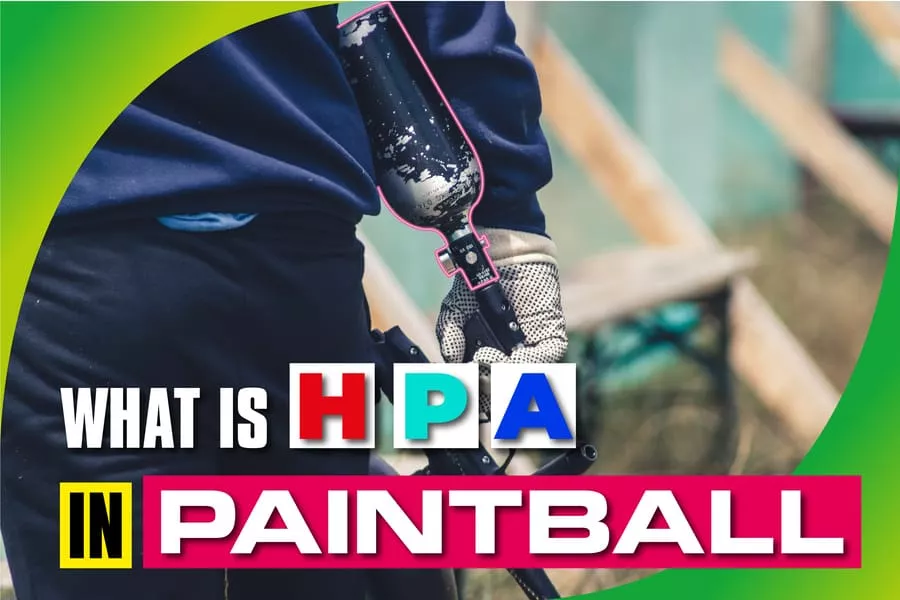New paintball players will always have questions, and they’re always welcome to ask any question they deem fit. Asking questions about paintball will enable you to understand and appreciate the sport better.
One of the common questions you can expect from paintballers is, “what is HPA in paintball?” But really, doesn’t the term sound like one of those lines from a rap song? Anyway, just kidding!
We’ll discuss what HPA means in paintball and go deeper to compare it to Co2 tanks.
Now, let’s get down to business!
What Is HPA In Paintball?
The meaning of HPA is “high pressure air.”It refers to compressed nitrogen or breathing air used for the filling of regulated compressed air bottles, including tanks.
Most modern paintball markers use these tanks to propel paintballs and for the re-cocking of semi-automatic paintball markers.
So, HPA is used in paintball guns and airsoft.
Paintball air tanks come in various sizes. For example, you’ll find HPA tanks in 3000 psi and 4500 psi. Another thing you need to know about these tanks is that they’re regulated for safety purposes.
The Number of Shots HPA Tanks Can Fire Compared To Co2 Tanks
Understanding the number of shots you can get from a specific HPA tank can prove helpful during battles. It will enable you to ensure you don’t run out of ammo or firepower before the combat ends.
So, check out the table below to know the number of paintballs you can fire from your HPA tank. We’ll consider various HPA tank sizes.
Then, we’ll discuss the number of shots the Co2 tanks can fire.
Compressed Air Tank Sizes (HPA)
| Tank Sizes | Shots (x-psi) | |||
| 3000 | 4500 | 5000 | ||
| 1. | 45-cu | 450 | 675 | 742 |
| 2. | 68-cu | 680 | 1020 | 1122 |
| 3. | 88-cu | 880 | 1320 | 1452 |
| 4. | 96-cu | 960 | 1440 | 1584 |
| 5. | 110-cu | 1100 | 1650 | 1815 |
| 6. | 114-cu | 1140 | 1710 | 1881 |
| 7. | 128-cu | 1280 | 1920 | 2112 |
Now, how many shots can the Co2 Tank fire? Check out the table below.
| Carbon Dioxide (Co2) Tanks | ||
| Size | Shots | |
| 1. | 12-g | 35 |
| 2. | 3.5-oz | 150 |
| 3. | 7-oz | 350 |
| 4. | 9-oz | 425 |
| 5. | 12-oz | 600 |
| 6. | 14-oz | 700 |
| 7. | 16-0z | 800 |
| 8. | 20-oz | 1100 |
| 9. | 24-oz | 1225 |
| 10. | 26-oz | 1300 |
| 11. | 30-oz | 1425 |
| 12. | 32-oz | 1500 |
| 13. | 36-oz | 1625 |
Here are the numbers of balls you can shoot from the various paintball tanks based on the standard outdoor temperature of 20 degrees centigrade.
You also need to understand that several factors determine the number of balls you can fire. Here are the factors below for easy understanding.
1: The paintball marketer’s efficiency rate: Efficiency rate differs from one marker to another and it’s something you can figure out.
You can visit your paintball gun’s manual to see the efficiency rate.
2: Temperature: The temperature outdoors will determine the number of balls your paintball marker can shoot, especially when using Co2 tanks.
If the outdoor temperature is colder, it means one thing: your tank will fire fewer paintballs.
As the temperature drops, the number of balls your paintball tank can shoot drops.
Again, keep in mind that when the pressure drops, you’ll require more volume of gas to fire paintballs.
A Handy Tip: Temperature doesn’t affect HPA tanks like it affects Co2 tanks. This explains why HPA tanks are preferred during cold winter periods.
3: Firing velocity setting: Paintball fields require paintballers to set their guns to speed of around 240 fps to 280 fps. For safety reasons, many fields don’t allow players to exceed these speed limits or range for paintball guns.
When the ball travels faster, it could burn your skin when it lands on it. But that isn’t the only thing that should bother you.
Take note: the firing velocity setting will determine the number of paintballs your tank can shoot. If the velocity is higher, you’ll need more gas to fire.
So, the higher your paintball gun’s firing velocity setting, the fewer balls the tank can shoot.
Note that the above factors apply to paintball guns with Co2 tanks.
A Must-Know Paintball HPA Tank Vs Co2 Tank Comparison
The primary difference between HPA and Co2 tanks is that HPA tanks are filled with compressed air (the air we breathe), while Co2 tanks are filled with Carbon Dioxide.
When you talk about stability, HPA tanks are the winners. They are more stable and boast a built-in regulator to ensure consistent output pressure.
The Co2 tank is the direct opposite of the HPA tank. Co2 is an unstable gas that changes its pressure as temperature changes.
So, one clear difference between HPA tanks and Co2 tanks is that the former isn’t susceptible to pressure changes like the latter.
In other words, it doesn’t matter whether the weather is extremely hot or cold. HPA tanks aren’t susceptible or affected by the temperature changes like Co2 tanks, making them a wise choice for playing paintball under any condition.
So, compressed air (HPA) tanks are consistent compared to Co2 tanks. And the more consistent pressure you get from the tank, the more consistent your performance will be.
One of the differences between a compressed air (HPA) tank and a Co2 tank is the price point. HPA’s initial cost is higher than Co2’s. However, your HPA tank will pay for itself over time.
So, in the long run, HPA tanks are cheaper. You’ll discover that most paintball fields offer all-day HPA tank fills. They allow players to pay a flat rate of about $5 to $10, and they can fill their tanks as often as they want throughout the day.
Another thing you must understand is that some paintball guns don’t work with compressed air. However, the general rule is that most electronic paintball markers can utilize compressed air, while mechanical paintball markers can use both Co2 and compressed air.
Co2 tanks also tend to be smaller and lighter than HPA and can yield similar shots per fill. On the other hand, HPA tanks are a bit bulky and larger than Co2 tanks.
HPA’s all-weather performance makes them a better option than Co2. Because Co2 is a liquid turned into gas, it will expand as it starts cooling. That’s why markers with Co2 tanks can be frustrating to use sometimes.
Another advantage HPA tanks have is that you can transfer to any paintball gun that you upgrade to.
When it comes to the ease of tank refill, Co2 tanks are the winners. In other words, you can get Co2 tank refills at a wide range of shops, not just specialty stores or paintball fields.
A Handy Tip: Many older paintball guns were designed to work with the Co2 tank. So, if you have older paintball guns, you’re better off with Co2 tanks.
But then, who needs older paintball guns when modern ones are more efficient and safer to use?
Understand that HPA (compressed air tanks) is the new kid on the block, displacing Co2, but the latter isn’t going down quietly.
Are HPA Tanks Taking The Place of Co2?
Yes, HPA tanks are gradually taking over, and the reasons are obvious. Firstly, HPA tanks comprise compressed air (the air we breathe). These tanks are also safe.
HPA tanks’ initial cost is high, but you’ll discover that they’re cheaper in the long run. On the other hand, Co2 tanks’ initial cost is low, but they are more expensive in the long run. Why? The simple reason is that Co2’s supply and delivery cost is high.
Furthermore, Co2 tank refill is more time-consuming. You’ll need special training and specialized fitting to get it done.
Here are other advantages HPA tanks have that make them a wise choice.
- You’ll have more flexibility when using HPA tanks.
- HPA tanks are more consistent, one of their biggest advantages over Co2 tanks.
- A high-pressure compressor is all you require for an HPA tank refill.
Conclusion
What is HPA in paintball? You can see the answer we gave. HPA means “high-pressure air.”It refers to compressed nitrogen or breathing air used to fill regulated compressed air bottles and tanks.
HPA tanks are commonly used on electronic-powered paintball guns. This is because they are more consistent and cheaper in the long run.
HPA tanks are filled with the same air we breathe. As a result, these tanks are also safer and extremely efficient. And they are a clean source of air power for markers at every stage of the game.
However, you can check out the advantages HPA has over Co2 before making your choice.

